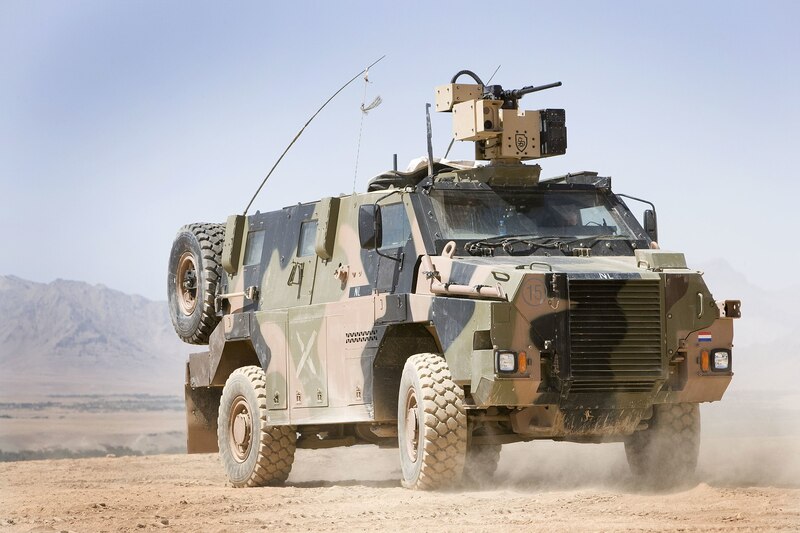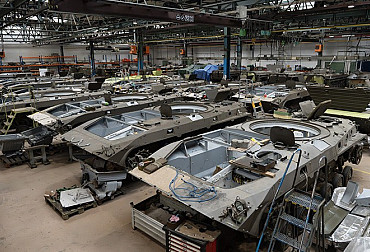Engineer platform for the Czech Army: the TITUS armoured personnel carrier offers the optimal solution
Although modern warfare has brought many new and revolutionary technologies to the scene, many of the basic tenets of historical warfare remain valid. These include, for example, the enormous importance of well-constructed defences, as evidenced by the course of the war in Ukraine, where significant losses on both sides were caused by mines. Armoured personnel carriers and various mine clearance systems and other engineering work are thus important items on Western aid lists for Ukraine, and equally important for the armies of NATO and EU countries that intend to strengthen their capabilities in this area.
Some of them started this process even before the outbreak of the war in Ukraine, because the asymmetric conflicts in Afghanistan and Iraq had already pointed very strongly to the great threat posed by mines and improvised explosive devices. The Czech Army also wants to enrich the arsenal of engineers with a new wheeled universal platform, but the news about the choice of this platform has started to arouse some controversy in professional circles (In CZ DEFENCE we wrote about the topic of new engineer vehicles in December last year). Already on 27 September 2021, a contract for a feasibility study was concluded, which in 2022 led to the conclusion that the optimal universal platform for Czech engineers is the Bushmaster PMV (Protected Mobility Vehicle) armoured vehicle from the Australian company Thales Australia.

The Czech army is reportedly to acquire dozens of vehicles under the name UKP (universal wheeled platform) in three different versions, the first of which is intended to provide road clearance (RCP), the second to ensure the disposal of explosive devices (EOD) and the third to provide engineer support (ZEN). In addition to the vehicles themselves, additional equipment and spare parts must be purchased, and maintenance of the armoured vehicles and training of the crews must be ensured. At IDET 2023, a memorandum of understanding was signed between Thales and the Czech state-owned enterprise VOP CZ, which should participate in the implementation of the project. Among the partners on the Czech side is also Pramacom-HT, which should supply some of the systems.
This news has naturally aroused media interest in the Bushmaster PMVs, which are otherwise relatively little-known products here. It is no exaggeration to say that most of the general public only became aware of the existence of this vehicle in 2022, when Australia began sending Bushmaster armoured vehicles to the defending Ukrainian army. In addition to the vehicle's operations in Ukraine, the Bushmaster is deployed in two NATO countries, the UK and the Netherlands. The biggest user is of course Australia itself, which has ordered over a thousand vehicles, and the list of other operators includes New Zealand, Indonesia, Japan, Jamaica and Fiji. Series production of the Bushmaster began in 1997 and these armoured vehicles have appeared in a number of conflict zones, including Afghanistan, Iraq and Mali. In terms of design, it is a standard MRAP (Mine Resistant Ambush Protected) armoured vehicle, i.e. a vehicle designed primarily for patrolling and escorting convoys and providing protection to its crew against ballistic and explosive threats. The Bushmaster vehicle has proved to be a very successful vehicle overall and is expected to continue in production.
From a purely tactical and technical point of view, the acquisition of this platform for the Czech Army would seem to make sense. At the same time, however, it is also necessary to mention other facts or ask some questions. The Bushmaster, as a classic MRAP armoured personnel carrier, whose design dates back to the late 1990s, is not really a versatile platform, as it was built in its time mainly as a patrol and escort vehicle, not for engineering tasks. While the Australian Army and some other users have adopted some purpose-built variants into service, including engineer variants, these are, by design, only minor modifications to the basic version for transport and use of relevant equipment. While users are generally satisfied with the Bushmaster vehicles, the Australian Army itself is already recognising the obsolescence of this design and is beginning to look for a possible replacement to introduce into its armoury over the next decade, whereas the Bushmaster vehicles will probably be handed over to the allies over time.
However, the most important question regarding the possible acquisition of Bushmaster armoured vehicles for the Czech Army concerns the actual need to buy another wheeled armoured platform of foreign origin. The Czech army currently operates four main platforms of this type, namely the Pandur II 8x8, TITUS, Dingo 2 and Iveco LMV (plus several older types that are being phased out). In addition, there is still a debate about the correctness of the Dingo 2 vehicles, as these armoured vehicles have not proved very successful and their deployment abroad has brought operational problems. It is thus questionable whether it is necessary to introduce another wheeled armoured platform in the form of the Bushmaster vehicle into the armament of the Czech Army, which would inevitably mean greater logistical complications for the Czech Army's fleet, as a completely new maintenance and repair system would obviously have to be built for them. The purchase of a new platform would make sense in a situation where the domestic industry would not be able to offer a comparable vehicle, but the Czech defence industry's portfolio includes up to four types of armoured vehicles potentially suitable for the engineer role.
If we focus first on vehicles with four-wheel chassis, a category to which the Bushmaster itself belongs, then the Gerlach armoured vehicle from Zetor comes to mind. It was originally developed mainly for the Slovak army's tenders, but it is also possible to imagine its introduction into the Czech army.

Another candidate could probably be the MARS armoured personnel carrier, which comes from the SVOS company in Přelouč. The manufacturer declares that this vehicle is intended mainly for special roles, for which it is predestined, for example, by its chassis with the possibility of independent steering of all wheels. MARS could therefore certainly serve as a universal engineer platform.

Last but not least, the Patriot II 4x4 armoured personnel carrier from Excalibur Army, which has also achieved export success. It has already found its application, for example, in armies in the Middle East and East Asia, and the Polish army plans to introduce over a thousand of these machines in various versions into its arsenal. An indisputable advantage of the Patriot II 8x8 vehicle is the fact that it is built on a Tatra chassis and also uses Tatra engines for propulsion, which, in addition to its excellent mobility in difficult terrain, also means its technical affinity with vehicles already in use in the Czech Army.

The ideal solution to the question of a universal wheeled platform for Czech engineers would be another, larger vehicle, namely the six-wheeled armoured personnel carrier TITUS from Tatra Defence Vehicle. This is also a platform built on a chassis from the Kopřivnice automotive plant, but the biggest benefit of the TITUS armoured vehicle is the fact that it is already in service with the Czech Army, which has ordered a total of 62 vehicles in three modifications, KOVS, KOVVŠ and MKPP. The first version serves as a liaison, the second provides command and staff tasks and the third functions as a fire support coordination point, i.e. actually a means of artillery fire control. However, the 62 examples are said to represent only the beginning, as the Czech Army has previously declared its intention to introduce a much higher number of TITUS vehicles.

The TITUS platform is a truly versatile armoured vehicle of the MRAV (Multi-Role Armoured Vehicle) category, which the manufacturer has already declared in the past by presenting studies, models or prototypes of a wide range of purpose-built variants. This range also includes the engineer version of the TITUS vehicle, which the public could see at IDET 2021 and which was equipped with the SCD(L) (Surface Clearance Device Light) system for clearing mines and other explosive devices. This product from the British company Pearson Engineering works essentially like a plough to remove explosive or otherwise dangerous objects from the road. In addition to the V-shaped plough, which is suitable for clearing roads and was featured on the TITUS vehicle in 2021, there is also a straight plough, which is used for clearing larger areas. It is thus clear that the TITUS armoured vehicle in the configuration on display essentially corresponds to what the Army of the Czech Republic requires as a means of ensuring road clearance (RCP). The load capacity and modular design of the TITUS vehicle would then certainly also allow for the installation of a remotely operated working arm for pyrotechnic work (i.e. for the requested vehicle of the EOD category), as well as for the adaptation of the vehicle for general engineer support tasks (i.e. for the configuration called ŽEN).

The feasibility study mentioned in the introduction called for a universal platform weighing up to 20 tonnes, which the Bushmaster corresponds to, as its combat weight is approximately 15 tonnes. The Czech TITUS armoured vehicle is of course heavier, as its weight (depending on configuration) is between 23 and 27 tonnes. However, it also offers a higher carrying and transport capacity, as it can hold up to fourteen men, while the Australian vehicle can accommodate a maximum of ten men. Another advantage of the Czech six-wheeled armoured vehicle is its Tatra-style chassis, which ensures excellent passability even over difficult terrain, which can be extremely important for an engineer vehicle. In addition, it should be stressed that the TITUS is a domestic design whose production is fully localised, as Tatra six-wheel chassis and armoured bodies are mass-produced in the Czech Republic. And although, according to the available information, the domestic industry should also participate in the potential supply of Bushmaster vehicles to the Czech Army, it is unrealistic that its share in the implementation could reach a level comparable to the situation in which a fully Czech TITUS would be preferred.

The Czech Army's intention to purchase modern multi-purpose wheeled armoured vehicles for the engineer forces is undoubtedly a step in the right direction. The need to have effective means for ensuring road clearance or for defusing mines and other explosive devices has already been demonstrated by various expeditionary operations, and the current war in Ukraine only confirms that the army must have such tools even in a high-intensity conventional conflict. The choice of the Bushmaster vehicle for this role, however, raises various questions, especially in connection with the fact that it is a vehicle that is technically completely unrelated to any type of vehicle in the Czech Army. From the point of view of simplifying logistics and operational efficiency and, of course, from the point of view of supporting the defence industry, it would make more sense to choose a domestically produced armoured vehicle, which is also already included in the Czech Army. These attributes are met by the TITUS vehicle, which already exists in an engineer variant and offers parameters that would mean a dramatic improvement in capability for Czech engineers.





















